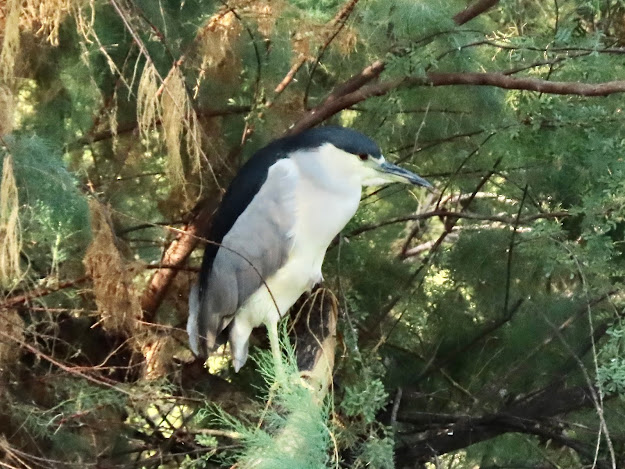SNOWY EGRET
Wednesday, September 9, 2020
Meeting friend, Lois Lorenz, at 5:40 a.m. in the parking lot of the Riparian Preserve felt very welcome; it had been more than six months since we had birded together! Now, that she has retired from a very busy job, she'll be more available to get out and about.
It seemed appropriate that our hot summer temperature had taken a sudden dip overnight to 64°F for this first in a long time get together. [Rain had happened in many nearby places last evening but I sat and watched rain on a news stream on my computer since we had none in AJ]
While rain makes the news in our hot desert environment, birds rarely do. Is that why I spend so much time with them? They are an overlooked part of our Earth Community, a part that can make us more whole and inclusive. Even prior to sunrise at the edge of Pond 7, we counted at least 80 Canada geese that had spent the night. They were just beginning to make communal sounds that would lead to their eventual departure.
Just shy of a 3-hour visit, we saw 43 species from just the northern portion of the Preserve. Best bird of the day was not photographed; it was migratory and busily snatching insects in a large mesquite tree: HERMIT WARBLER. What a time we had trying to keep up with it as it moved from limb to limb, rarely in the clear. It was gray above with two white wing bars, white below all the way to the under tail coverts. Eventually, the flashes of yellow came more fully to us! HERMIT WARBLER face and head! With too much cover for the bird to be seen in full at any time while we watched it for ten minutes just to ID it, there was no hope for me to get a photo. We treasured the thrill.
Focusing on the many wading birds at the Riparian area, I'll share a few species below.
BLACK-CROWNED NIGHT-HERON, the two birds below, have shorter legs than most waders and choose to perch just above the water line where, with their red eyes, they can see the variety of prey in the water. The first is a juvenile that will grow to look like the adult (photo beneath it).
GREEN HERON is another wader with shorter legs that will walk the shallows in search of its food, or like the BCNHs above, will perch quite close the water.
BLACK-NECKED STILT is a joy to watch as it wades through a pond.
GREATER YELLOWLEGS were gathered, it seemed, at Pond 5, where two or three were bathing while the others foraged.
GREAT BLUE HERON were present in more numbers than they have been all summer. Although its legs are plenty long for wading it, too, will perch higher above a pond. Perhaps breakfast is over and it's scanning for brunch.
Although several GREAT EGRET were present at the ponds, they were quite distant from where I was walking so I opted for the SNOWY EGRET instead -- the one with "golden slippers".
Land birds included RED-WINGED BLACKBIRD, WHITE-WINGED DOVE and a molting GREAT-TAILED GRACKLE missing its long tail feathers that will grow back.
Many flocks were in the air this morning: ducks, the CAGO, lots of doves, turkey vultures, and a hawk. It's been weeks since I've spotted a hawk at the Preserve. We had two: a COOPER'S that snuggled into the middle of a thin tamarisk to hide and a Juvenile Western RED-TAILED HAWK that is lighter colored than many other Red-taileds and the juvie has a barred tail.
Only 79°F when we finished up, it had turned out to be an exquisite day at the Water Ranch.
Until next time.....
* * *
View this checklist online at https://ebird.org/checklist/S73379365
















No comments:
Post a Comment